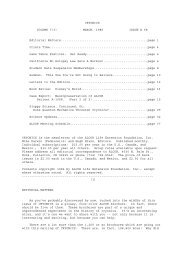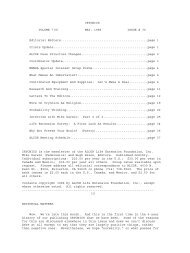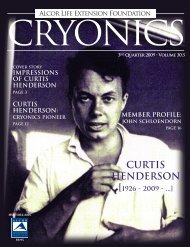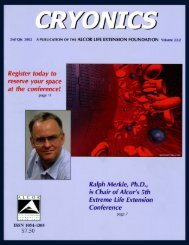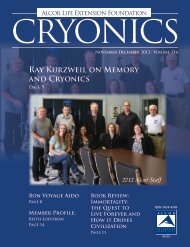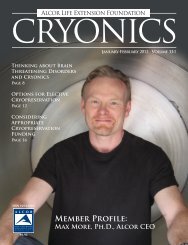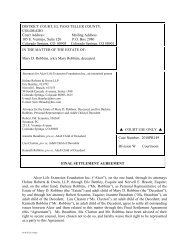Download PDF - Alcor Life Extension Foundation
Download PDF - Alcor Life Extension Foundation
Download PDF - Alcor Life Extension Foundation
Create successful ePaper yourself
Turn your PDF publications into a flip-book with our unique Google optimized e-Paper software.
Dear CRYONICS,<br />
I want to see <strong>Alcor</strong> and cryonics<br />
in general grow; but I understand<br />
that, as of this moment, about a<br />
thousand or so people are members<br />
of <strong>Alcor</strong>. Hardly a trend. Maybe<br />
there is some way we could push a<br />
little. I call up all the local talk radio<br />
shows and try to discuss cryonics<br />
with the hosts. No real response<br />
comes from this, but I’m stubborn.<br />
Perhaps word of mouth is the<br />
best way to inform people of the<br />
existence of cryonics; it is apparent<br />
that most are only very vaguely<br />
aware of it- cryonics is like the<br />
spacestation - “someone may be<br />
working on it.” There seems to be<br />
a consensus that Walt Disney is in<br />
suspension, though he is not.<br />
I think we should swallow our<br />
fear of being rebuffed and tell<br />
everyone we meet about cryonics,<br />
yes, EVERYONE. It’s the ‘law’ of<br />
Letters to the Editors<br />
averages; tell 100 people about<br />
something and though 99 may<br />
ignore it, there’s a good chance<br />
one individual won’t. I take my<br />
own advice - I carry a copy of<br />
CRYONICS all the time, it makes<br />
a great conversation piece: “Imagine<br />
that! A magazine about<br />
FREEZING people!”<br />
Sincerely,<br />
Never T. Late<br />
910 Portland Place<br />
Boulder, Colorado 80304<br />
(Never T. Late is an actual name, legally<br />
changed, according to the writer. This is<br />
an increasingly common practice.)<br />
Editor’s comment:<br />
<strong>Alcor</strong>’s membership is a bit<br />
short of 1,000, more like 500 (see<br />
elsewhere in the issue for figures.)<br />
Before I signed up in 1970, I felt<br />
the same as the writer of this letter<br />
to CRYONICS, talking about the<br />
idea with many people. Some of<br />
them were relatives with terminal<br />
illness. None of them got in touch<br />
with the existing groups of the day<br />
and none were suspended.<br />
Only when my mother died<br />
and was not suspended for lack of<br />
prearrangements, did I see the<br />
necessity to plan ahead; after that,<br />
I became energetically involved.<br />
Presently, those with active<br />
arrangements are perhaps one or<br />
two in each million people (in the<br />
U.S.). By the time one person in<br />
each hundred chooses it, we will<br />
have grown by a factor of about<br />
ten thousand. Over the next 30 to<br />
40 years, such a transition might<br />
take place. Keep carrying those<br />
issues of CRYONICS with you,<br />
and we’ll keep trying to make<br />
them better “door openers!” (F)<br />
NANOTECHNOLOGY AT THE NATIONAL LEVEL<br />
In the last issue of Cryonics<br />
we noted that on June 22, 1999,<br />
Ralph Merkle and others appeared<br />
before the 106th Congress Subcommittee<br />
on Basic Science to<br />
testify concerning the potential of<br />
nanotechnology. A follow-up of<br />
where that seems to be leading<br />
appeared in the New York Times<br />
recently. It’s fascinating that the<br />
long-range goals of basic molecular<br />
manufacturing are now being<br />
presented by a U.S. President as a<br />
challenge, in a similar spirit to that<br />
which launched the space industry.<br />
(See: http://www.nytimes.com/library/<br />
tech/00/01/biztech/articles/21chip.html)<br />
A Clinton Initiative<br />
in a Science of Smallness<br />
This was the title of an article by<br />
John Markoff for the New York<br />
Times, published January 21, 2000<br />
on its website (URL at the lower left.)<br />
Markoff noted that the Clinton<br />
administration would soon announce<br />
an ambitious program to accelerate<br />
basic research in nanotechnology and<br />
commented as follows:<br />
“Nanotechnology is widely<br />
considered an extremely promising<br />
area of science and engineering, but it<br />
has realized only limited commercial<br />
success to date.”<br />
Markoff’s report said President<br />
Clinton would make a speech at Cal<br />
Tech stressing the importance of<br />
expanding basic research in both the<br />
physical and biological sciences. As<br />
part of the speech, Clinton was to<br />
announce a plan to ask Congress to<br />
finance a National Nanotechnology<br />
Initiative, which would encourage<br />
basic research in a wide range of<br />
nanotechnology-related areas.<br />
Specifically, Markoff said, “The<br />
President will set out these ‘grand<br />
challenges’: Shrinking the entire<br />
contents of the Library of Congress<br />
into a device the size of a sugar cube;<br />
assembling new materials from the<br />
‘bottom up’ — from atoms and<br />
molecules; developing ultralight<br />
materials that are 10 times as strong as<br />
steel; creating a new class of computer<br />
(Continued on page 14)<br />
1st Qtr. 2000 • Cryonics 3



